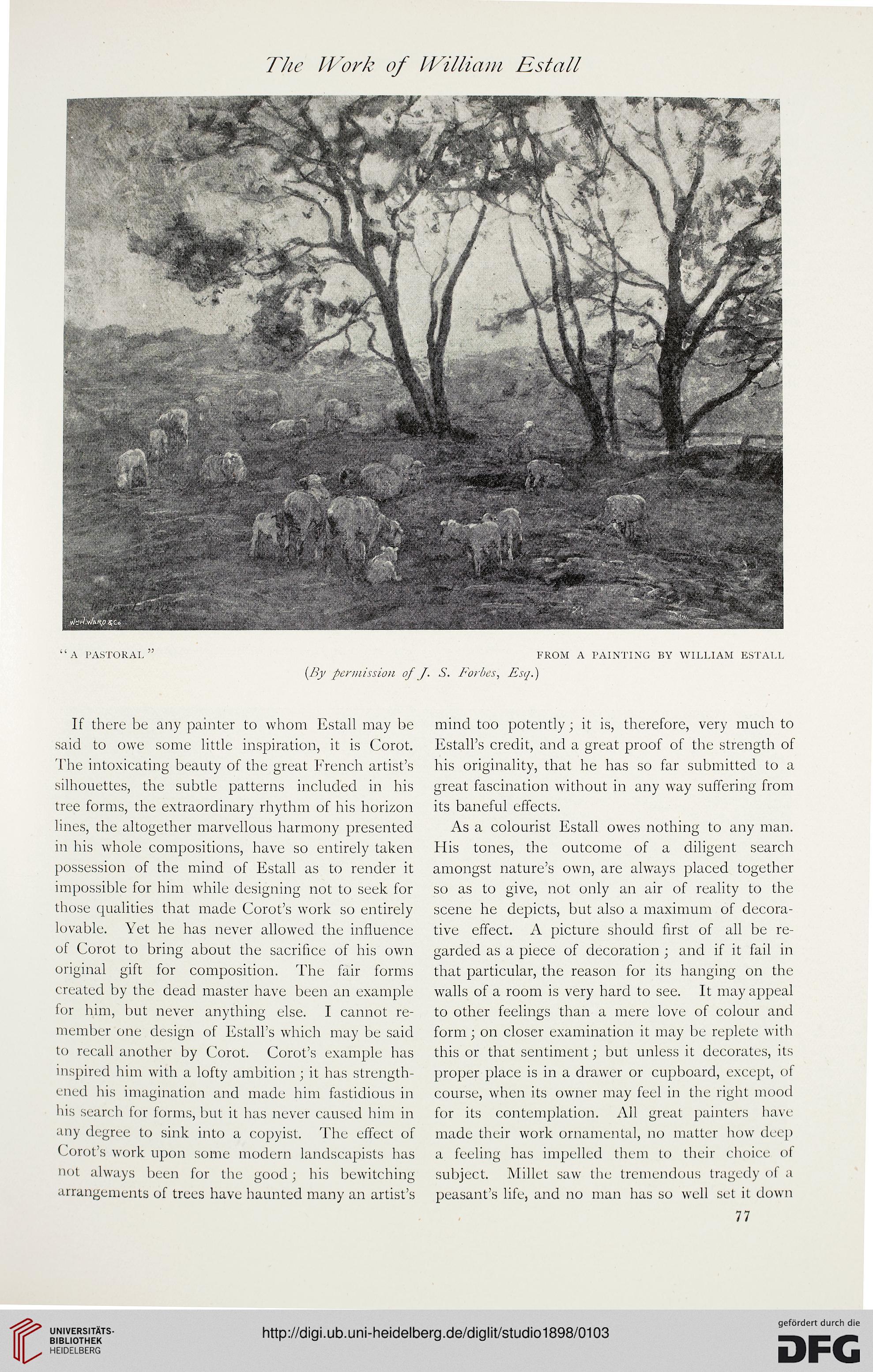llic Work of William Estall
If there be any painter to whom Estall may be
said to owe some little inspiration, it is Corot.
The intoxicating beauty of the great French artist's
silhouettes, the subtle patterns included in his
tree forms, the extraordinary rhythm of his horizon
lines, the altogether marvellous harmony presented
in his whole compositions, have so entirely taken
possession of the mind of Estall as to render it
impossible for him while designing not to seek for
those qualities that made Corot's work so entirely
lovable. Yet he has never allowed the influence
of Corot to bring about the sacrifice of his own
original gift for composition. The fair forms
created by the dead master have been an example
for him, but never anything else. I cannot re-
member one design of Estall's which may be said
to recall another by Corot. Corot's example has
inspired him with a lofty ambition ; it has strength-
ened his imagination and made him fastidious in
his search for forms, but it has never caused him in
any degree to sink into a copyist. The effect of
Corot's work upon some modern landscapists has
not always been for the good; his bewitching
arrangements of trees have haunted many an artist's
mind too potently; it is, therefore, very much to
Estall's credit, and a great proof of the strength of
his originality, that he has so far submitted to a
great fascination without in any way suffering from
its baneful effects.
As a colourist Estall owes nothing to any man.
His tones, the outcome of a diligent search
amongst nature's own, are always placed together
so as to give, not only an air of reality to the
scene he depicts, but also a maximum of decora-
tive effect. A picture should first of all be re-
garded as a piece of decoration ; and if it fail in
that particular, the reason for its hanging on the
walls of a room is very hard to see. It may appeal
to other feelings than a mere love of colour and
form ; on closer examination it may be replete with
this or that sentiment; but unless it decorates, its
proper place is in a drawer or cupboard, except, of
course, when its owner may feel in the right mood
for its contemplation. All great painters have
made their work ornamental, no matter how deep
a feeling has impelled them to their choice oi
subject. Millet saw the tremendous tragedy oi a
peasant's life, and no man has so well set it down
77
If there be any painter to whom Estall may be
said to owe some little inspiration, it is Corot.
The intoxicating beauty of the great French artist's
silhouettes, the subtle patterns included in his
tree forms, the extraordinary rhythm of his horizon
lines, the altogether marvellous harmony presented
in his whole compositions, have so entirely taken
possession of the mind of Estall as to render it
impossible for him while designing not to seek for
those qualities that made Corot's work so entirely
lovable. Yet he has never allowed the influence
of Corot to bring about the sacrifice of his own
original gift for composition. The fair forms
created by the dead master have been an example
for him, but never anything else. I cannot re-
member one design of Estall's which may be said
to recall another by Corot. Corot's example has
inspired him with a lofty ambition ; it has strength-
ened his imagination and made him fastidious in
his search for forms, but it has never caused him in
any degree to sink into a copyist. The effect of
Corot's work upon some modern landscapists has
not always been for the good; his bewitching
arrangements of trees have haunted many an artist's
mind too potently; it is, therefore, very much to
Estall's credit, and a great proof of the strength of
his originality, that he has so far submitted to a
great fascination without in any way suffering from
its baneful effects.
As a colourist Estall owes nothing to any man.
His tones, the outcome of a diligent search
amongst nature's own, are always placed together
so as to give, not only an air of reality to the
scene he depicts, but also a maximum of decora-
tive effect. A picture should first of all be re-
garded as a piece of decoration ; and if it fail in
that particular, the reason for its hanging on the
walls of a room is very hard to see. It may appeal
to other feelings than a mere love of colour and
form ; on closer examination it may be replete with
this or that sentiment; but unless it decorates, its
proper place is in a drawer or cupboard, except, of
course, when its owner may feel in the right mood
for its contemplation. All great painters have
made their work ornamental, no matter how deep
a feeling has impelled them to their choice oi
subject. Millet saw the tremendous tragedy oi a
peasant's life, and no man has so well set it down
77




